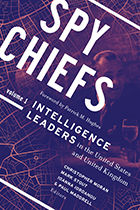NEW: Book Review - Spy Chiefs Volume 1
- Luca Trenta
- May 17, 2018
- 3 min read
Christopher Moran, Mark Stout, Ioanna Iordanu, Paul Maddrell, Spy Chiefs, Volume 1: Intelligence Leaders in the United States and United Kingdom, (Washington: Georgetown University Press, 2018, Price $29.95 Pp 352; ISBN 9781626165199.
This review will appear in the Journal of American Studies
In March of 1975, at the height of Congressional inquiries on the activities of the CIA and the intelligence community, former CIA Director Richard Helms expressed all his frustration regarding the behaviour of CIA Director William Colby: “I must say that Colby has done a startlingly successful job at making a total mess.” As Christopher Moran (p. 118) writes in his chapter on ‘the man who kept the secrets’ Colby was, in Helms’s mind, guilty of having opened up the CIA to public scrutiny. Secrecy was Richard Helms’s main principle.
Secrecy is also one of the main lenses that guide the analysis of British and American spy-chiefs in this edited volume. The book is divided into three main parts. The first part of the book deals with spy chiefs in the United States. These include directors of the CIA, the NSA, and other past intelligence agencies. The second part looks at spy chiefs in the United Kingdom. The third one – also in the section on the United Kingdom – looks at how spy chiefs have been interpreted and presented in popular culture. One chapter, authored by Michael VanBlaricum, looks at, perhaps, the most famous of spy chiefs James Bond’s boss – ‘M’ – and at his creator, Ian Fleming. The final chapter looks at the portrayal of British spy chiefs in popular TV series.

The book is a well-crafted collection. It looks at both notorious figures like Allen Dulles and Stewart Menzies, and less notorious ones like William Odom and John Grombach. The three lenses suggested by the co-authors are pertinent and convincing. In particular, while the lenses of power and secrecy are, perhaps, inevitable, the co-authors stress the importance of leadership. They seem to adopt a comprehensive understanding of leadership looking at strategic, organizational, and ideational factors. As they write in the introductory chapter (p.10): ‘leadership presupposes the social construction of the context that legitimizes a certain action by a group at a specific point in time.’ There is, in this sense, an attention to ideas. These take centre stage in Andrew Hammond’s chapter on William Casey, Ronald Reagan’s Director of the CIA. It is in this context that the book shows its greatest strength. Even when the book discusses well-known figures or events, the authors of the collection are able to provide an innovative perspective. The chapter on William Donovan, for example, looks at the role of religion in the conduct of the OSS suggesting that the CIA’s disregard of the religious dimension was detrimental to US intelligence. The chapter on Allen Dulles, possibly the CIA’s greatest spymaster, looks at his influence on the Agency, but also at his failures in PBSuccess. Rory Cormac’s chapter on Stewart Menzies looks at his influence on the British approach to covert action, and, as mentioned, Hammond’s chapter looks at William Casey through the lens of one key idea: freedom.
The original content of most chapters in the book is also reason for a word of caution. In spite of the title of the book, this is not an introductory text on the life and times of spy masters. It is a research-driven book, targeted at a more experienced audience with an interest in the complexities of intelligence and intelligence studies. Even this audience, however, has much to learn from this book, its innovative perspective, and its less-known stories like the origins and death of the ‘Pond’ an early alternative to the CIA in Mark Stout’s chapter, or the rocky relationship between Director of the NSA William Odom and his counterparts in the British GCHQ, detailed in Richard Aldrich’s chapter.
Two minor criticisms can be leveled at the book. First, the book could have included some less notorious and more controversial figures, especially on the US side. William Colby, James Schlesinger, and Stansfield Turner come to mind. Second, the book could have also included a chapter on the portrayal of American spy chiefs in popular culture, either on TV as in The Americansand Homelandor in fiction as in novels by David Ignatius or Tom Clancy. These, however, are more suggestions than criticism. The volume deserves a place on the bookshelf of intelligence studies, Special Relationship, US and UK foreign policy academics as well as enthusiasts.




Comments